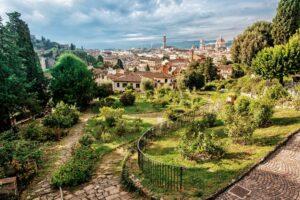Fodor's Expert Review Palazzo Rucellai
Architect Leon Battista Alberti (1404–72) designed perhaps the very first private residence inspired by antique models—which goes a step further than the Palazzo Strozzi. A comparison between the two is illuminating. Evident on the facade of the Palazzo Rucellai, dating between 1455 and 1470, is the ordered arrangement of windows and rusticated stonework seen on the Palazzo Strozzi, but Alberti's facade is far less forbidding. He devoted a far larger proportion of his wall space to windows, which lighten the facade's appearance, and filled in the remainder with rigorously ordered classical elements borrowed from antiquity. The result, though still severe, is less fortresslike, and Alberti strove for this effect purposely (he is on record as saying that only tyrants need fortresses).
Ironically, the Palazzo Rucellai was built some 30 years before the Palazzo Strozzi. Alberti's civilizing ideas here, it turned out, had little influence on the Florentine palazzi that followed.... READ MORE
Architect Leon Battista Alberti (1404–72) designed perhaps the very first private residence inspired by antique models—which goes a step further than the Palazzo Strozzi. A comparison between the two is illuminating. Evident on the facade of the Palazzo Rucellai, dating between 1455 and 1470, is the ordered arrangement of windows and rusticated stonework seen on the Palazzo Strozzi, but Alberti's facade is far less forbidding. He devoted a far larger proportion of his wall space to windows, which lighten the facade's appearance, and filled in the remainder with rigorously ordered classical elements borrowed from antiquity. The result, though still severe, is less fortresslike, and Alberti strove for this effect purposely (he is on record as saying that only tyrants need fortresses).
Ironically, the Palazzo Rucellai was built some 30 years before the Palazzo Strozzi. Alberti's civilizing ideas here, it turned out, had little influence on the Florentine palazzi that followed. To Renaissance Florentines, power—in architecture, as in life—was equally as impressive as beauty. While you are admiring the facade (the palazzo isn't open to the public), turn around and look at the Loggia dei Rucellai across the street. Built in 1463–66, it was the private "terrace" of the Rucellai family, in-laws to the Medici. Its soaring heights and grand arches are a firm testament to the family's status and wealth.
READ LESS







